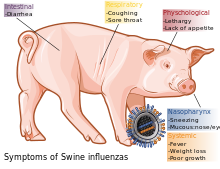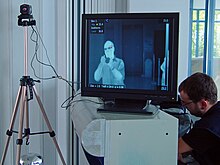| Article Index |
|---|
| Swine Flu |
| Page 2 |
| Page 3 |
| Page 4 |
| All Pages |
1998 US outbreak in Swine
In 1998, swine flu was found in pigs in four U.S. states. Within a year, it had spread through pig populations across the United States. Scientists found this virus had originated in pigs as a recombinant form of flu strains from birds and humans. This outbreak confirmed that pigs can serve as a crucible where novel influenza viruses emerge as a result of the reassortment of genes from different strains.[44][45][46] Genetic components of these 1998 triple-hybrid stains would later form six out of the eight viral gene segments in the 2009 flu outbreak.[47][48][49][50][51]
2007 Philippine outbreak in swine
|
|
This section requires expansion. (April 2009) |
On August 20, 2007, the Department of Agriculture officers investigated the outbreak (epizootic) of swine flu in Nueva Ecija and central Luzon, Philippines. The mortality rate is less than 10% for swine flu, unless there are complications like hog cholera. On July 27, 2007, the Philippine National Meat Inspection Service (NMIS) raised a hog cholera "red alert" warning over Metro Manila and five regions of Luzon after the disease spread to backyard pig farms in Bulacan and Pampanga, even if these tested negative for the swine flu virus.[52][53]
2009 Northern Ireland outbreak in swine
Since November 2009, 14 deaths as a result of swine flu in Northern Ireland have been reported. The majority of the victims were reported to have pre-existing health conditions which had lowered their immunity. This closely corresponds to the 19 patients who had died in the year prior due to swine flu, where 18 of the 19 were determined to have lowered immune systems. Because of this, many mothers who have just given birth are strongly encouraged to get a flu shot because their immune systems are vulnerable. Also, studies have shown that people between the ages of 15 and 44 have the highest rate of infection. Although most people now recover, having any conditions that lower one's immune system increases the risk of having the flu become potentially lethal. In Northern Ireland now, approximately 56% of all people under 65 who are entitled to the vaccine have gotten the shot, and the outbreak is said to be under control.[54]
H1N1 virus pandemic history
A study conducted in 2008, and published in the journal Nature, has managed to establish the evolutionary origin of the flu strain of swine origin (S-OIV).[55]
The phylogenetic origin of the flu virus that caused the 2009 pandemics can be traced before 1918. Around 1918, the ancestral virus, of avian origin, crossed the species boundaries and infected humans as human H1N1. The same phenomenon took place soon after in America, where the human virus was infecting pigs; it led to the emergence of the H1N1 swine strain, which later became the classic[clarification needed] swine flu.
New events of reassortment were not reported until 1968, when the avian strain H1N1 infected humans again; this time the virus met the strain H2N2, and the reassortment originated the strain H3N2. This strain has remained as a stable flu strain until now.
The mid-1970s were important for the evolution of flu strains. First, the re-emergence of the human H1N1 strain became a seasonal strain. Then, a small outbreak of swine H1N1 occurred in humans, and finally, the human H2N2 strain apparently became extinct. Around 1979, the avian H1N1 strain infected pigs and gave rise to Euroasiatic swine flu and H1N1 Euroasiatic swine virus, which is still being transmitted in swine populations.
The critical moment for the 2009 outbreak was between 1990 and 1993. A triple reassortment event in a pig host of North American H1N1 swine virus, the human H3N2 virus and avian H1N1 virus generated the swine H1N2 strain. Finally, the last step in S-OIV history was in 2009, when the virus H1N2 co-infected a human host at the same time as the Euroasiatic H1N1 swine strain. This led to the emergence of a new human H1N1 strain, which caused the 2009 pandemic.
On June 11, 2009, the World Health Organization raised the worldwide pandemic alert level to Phase 6 for swine flu, which is the highest alert level.[56] This alert level means that the swine flu had spread worldwide and there were cases of people with the virus in most countries. The pandemic level identifies the spread of the disease or virus and not necessarily the severity of the disease.
Swine flu spread very rapidly worldwide due to its high human-to-human transmission rate and due to the frequency of air travel.[56]
In 2015 the instances of Swine Flu substantially increased to five year highs with over 6298 cases reported in India causing government to step up efforts. [57]
Transmission
Transmission between pigs
Influenza is quite common in pigs, with about half of breeding pigs having been exposed to the virus in the US.[58] Antibodies to the virus are also common in pigs in other countries.[58]
The main route of transmission is through direct contact between infected and uninfected animals.[11] These close contacts are particularly common during animal transport. Intensive farming may also increase the risk of transmission, as the pigs are raised in very close proximity to each other.[59][60] The direct transfer of the virus probably occurs either by pigs touching noses, or through dried mucus. Airborne transmission through the aerosols produced by pigs coughing or sneezing are also an important means of infection.[11] The virus usually spreads quickly through a herd, infecting all the pigs within just a few days.[2] Transmission may also occur through wild animals, such as wild boar, which can spread the disease between farms.[61]
Transmission to humans
People who work with poultry and swine, especially those with intense exposures, are at increased risk of zoonotic infection with influenza virus endemic in these animals, and constitute a population of human hosts in which zoonosis and reassortment can co-occur.[62] Vaccination of these workers against influenza and surveillance for new influenza strains among this population may therefore be an important public health measure.[63] Transmission of influenza from swine to humans who work with swine was documented in a small surveillance study performed in 2004 at the University of Iowa.[64] This study, among others, forms the basis of a recommendation that people whose jobs involve handling poultry and swine be the focus of increased public health surveillance.[62] Other professions at particular risk of infection are veterinarians and meat processing workers, although the risk of infection for both of these groups is lower than that of farm workers.[65]
Interaction with avian H5N1 in pigs
Pigs are unusual as they can be infected with influenza strains that usually infect three different species: pigs, birds and humans.[66] This makes pigs a host where influenza viruses might exchange genes, producing new and dangerous strains.[66] Avian influenza virus H3N2 is endemic in pigs in China, and has been detected in pigs in Vietnam, increasing fears of the emergence of new variant strains.[67] H3N2 evolved from H2N2 by antigenic shift.[68] In August 2004, researchers in China found H5N1 in pigs.[69]
These H5N1 infections may be quite common; in a survey of 10 apparently healthy pigs housed near poultry farms in West Java, where avian flu had broken out, five of the pig samples contained the H5N1 virus. The Indonesian government has since found similar results in the same region. Additional tests of 150 pigs outside the area were negative.[70][71]
Signs and symptoms
In swine
In pigs, influenza infection produces fever, lethargy, sneezing, coughing, difficulty breathing and decreased appetite.[11] In some cases the infection can cause abortion. Although mortality is usually low (around 1–4%),[2] the virus can produce weight loss and poor growth, causing economic loss to farmers.[11] Infected pigs can lose up to 12 pounds of body weight over a three- to four-week period.[11]
In humans
Direct transmission of a swine flu virus from pigs to humans is occasionally possible ( zoonotic swine flu). In all, 50 cases are known to have occurred since the first report in medical literature in 1958, which have resulted in a total of six deaths.[73] Of these six people, one was pregnant, one had leukemia, one had Hodgkin's lymphoma and two were known to be previously healthy.[73] Despite these apparently low numbers of infections, the true rate of infection may be higher, since most cases only cause a very mild disease, and will probably never be reported or diagnosed.[73]
See also: See this video with subtitles on YouTube [74]
According to the Centers for Disease Control and Prevention (CDC), in humans the symptoms of the 2009 "swine flu" H1N1 virus are similar to those of influenza and of influenza-like illness in general. Symptoms include fever, cough, sore throat, body aches, headache, chills and fatigue. The 2009 outbreak has shown an increased percentage of patients reporting diarrhea and vomiting.[75] The 2009 H1N1 virus is not zoonotic swine flu, as it is not transmitted from pigs to humans, but from person to person.
Because these symptoms are not specific to swine flu, a differential diagnosis of probable swine flu requires not only symptoms, but also a high likelihood of swine flu due to the person's recent history. For example, during the 2009 swine flu outbreak in the United States, the CDC advised physicians to "consider swine influenza infection in the differential diagnosis of patients with acute febrile respiratory illness who have either been in contact with persons with confirmed swine flu, or who were in one of the five U.S. states that have reported swine flu cases or in Mexico during the seven days preceding their illness onset."[76] A diagnosis of confirmed swine flu requires laboratory testing of a respiratory sample (a simple nose and throat swab).[76]
The most common cause of death is respiratory failure. Other causes of death are pneumonia (leading to sepsis),[77] high fever (leading to neurological problems), dehydration (from excessive vomiting and diarrhea), electrolyte imbalance and kidney failure.[78] Fatalities are more likely in young children and the elderly.
Diagnosis
The CDC recommends real time PCR as the method of choice for diagnosing H1N1.[79] The oral or nasal fluid collection and RNA virus preserving filter paper card is commercially available.[80] This method allows a specific diagnosis of novel influenza (H1N1) as opposed to seasonal influenza. Near-patient point-of-care tests are in development.[81]
Prevention
Prevention of swine influenza has three components: prevention in swine, prevention of transmission to humans, and prevention of its spread among humans.
In swine
Methods of preventing the spread of influenza among swine include facility management, herd management, and vaccination (ATCvet code: QI09AA03). Because much of the illness and death associated with swine flu involves secondary infection by other pathogens, control strategies that rely on vaccination may be insufficient.
Control of swine influenza by vaccination has become more difficult in recent decades, as the evolution of the virus has resulted in inconsistent responses to traditional vaccines. Standard commercial swine flu vaccines are effective in controlling the infection when the virus strains match enough to have significant cross-protection, and custom (autogenous) vaccines made from the specific viruses isolated are created and used in the more difficult cases.[82][83] Present vaccination strategies for SIV control and prevention in swine farms typically include the use of one of several bivalent SIV vaccines commercially available in the United States. Of the 97 recent H3N2 isolates examined, only 41 isolates had strong serologic cross-reactions with antiserum to three commercial SIV vaccines. Since the protective ability of influenza vaccines depends primarily on the closeness of the match between the vaccine virus and the epidemic virus, the presence of nonreactive H3N2 SIV variants suggests current commercial vaccines might not effectively protect pigs from infection with a majority of H3N2 viruses.[73][84] The United States Department of Agriculture researchers say while pig vaccination keeps pigs from getting sick, it does not block infection or shedding of the virus.[85]
Facility management includes using disinfectants and ambient temperature to control viruses in the environment. They are unlikely to survive outside living cells for more than two weeks, except in cold (but above freezing) conditions, and are readily inactivated by disinfectants.[2] Herd management includes not adding pigs carrying influenza to herds that have not been exposed to the virus. The virus survives in healthy carrier pigs for up to three months, and can be recovered from them between outbreaks. Carrier pigs are usually responsible for the introduction of SIV into previously uninfected herds and countries, so new animals should be quarantined.[58] After an outbreak, as immunity in exposed pigs wanes, new outbreaks of the same strain can occur.[2]
In humans
- Prevention of pig-to-human transmission
Swine can be infected by both avian and human flu strains of influenza, and therefore are hosts where the antigenic shifts can occur that create new influenza strains.
The transmission from swine to humans is believed to occur mainly in swine farms, where farmers are in close contact with live pigs. Although strains of swine influenza are usually not able to infect humans, this may occasionally happen, so farmers and veterinarians are encouraged to use face masks when dealing with infected animals. The use of vaccines on swine to prevent their infection is a major method of limiting swine-to-human transmission. Risk factors that may contribute to swine-to-human transmission include smoking and, especially, not wearing gloves when working with sick animals, thereby increasing the likelihood of subsequent hand-to-eye, hand-to-nose or hand-to-mouth transmission.[86]
- Prevention of human-to-human transmission
Influenza spreads between humans when infected people cough or sneeze, then other people breathe in the virus or touch something with the virus on it and then touch their own face.[87] "Avoid touching your eyes, nose or mouth. Germs spread this way."[88] Swine flu cannot be spread by pork products, since the virus is not transmitted through food.[87] The swine flu in humans is most contagious during the first five days of the illness, although some people, most commonly children, can remain contagious for up to ten days. Diagnosis can be made by sending a specimen, collected during the first five days, for analysis.[89]






















